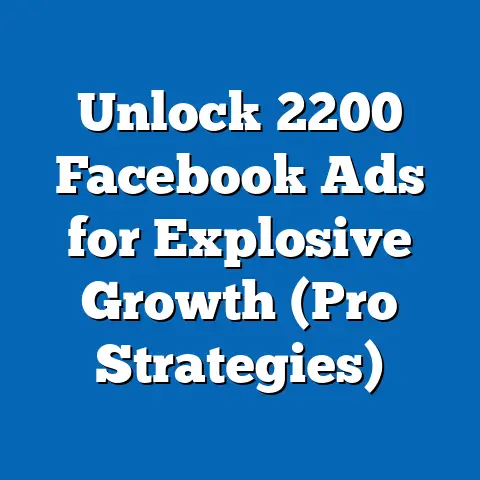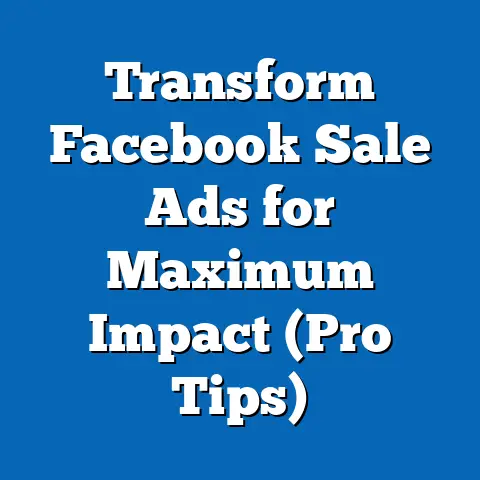Unlocking Video Ads on Facebook (Pro Strategies Revealed)
In the rapidly evolving landscape of digital marketing, video advertising on platforms like Facebook has emerged as a powerful tool for brands to connect with their audiences. However, as businesses strive to maximize reach and engagement, there’s an often-overlooked intersection between effective advertising and sustainability. Crafting video ad campaigns that resonate with environmentally conscious consumers while leveraging data-driven strategies can set brands apart in a crowded marketplace.
The Role of Sustainability in Digital Marketing
Sustainability is no longer a niche concern; it has become a central pillar in consumer decision-making and brand perception. According to a 2022 NielsenIQ report, 78% of global consumers say that a sustainable lifestyle is important to them, and 55% are willing to pay more for environmentally friendly products or services. This trend is particularly pronounced among younger demographics, with 73% of Millennials and 68% of Gen Z consumers prioritizing sustainability when choosing brands (NielsenIQ, 2022).
These statistics underscore a critical shift: brands that fail to integrate sustainability into their messaging risk alienating a significant portion of their audience. In the context of digital advertising, this means creating campaigns that not only promote products but also highlight a company’s commitment to environmental and social responsibility. Video ads, with their dynamic and engaging format, offer a unique opportunity to tell compelling sustainability stories.
Moreover, the digital advertising ecosystem itself is under scrutiny for its environmental impact. A 2021 study by Good-Loop revealed that online advertising generates approximately 60 million metric tons of CO2 emissions annually, equivalent to the emissions of a small country. As a result, brands are increasingly seeking ways to reduce their digital carbon footprint, such as optimizing ad delivery or partnering with platforms that prioritize sustainable practices.
Sustainability and Video Ads: A Growing Connection
When it comes to video advertising on platforms like Facebook, sustainability can be integrated into both content and strategy. For instance, brands can create video content that showcases eco-friendly initiatives, such as reducing plastic waste or supporting renewable energy. A 2023 survey by Statista found that 62% of consumers are more likely to engage with video content that highlights a brand’s sustainability efforts.
Demographically, the appeal of sustainable messaging varies. Gen Z, aged 18-24, shows the highest engagement with such content, with 71% stating they actively seek out brands with clear environmental commitments (Statista, 2023). In contrast, Baby Boomers, while still concerned about sustainability (54% express interest), are more likely to prioritize price and quality over eco-friendly claims.
Historically, sustainability in advertising was often seen as a secondary concern, with only 22% of brands incorporating green messaging in their campaigns as recently as 2015 (Nielsen, 2015). Today, that figure has risen to 58%, reflecting a seismic shift in priorities driven by consumer demand and regulatory pressures (NielsenIQ, 2022). This trend is expected to accelerate, with projections suggesting that by 2025, over 80% of global brands will include sustainability as a core component of their marketing strategies.
Why Facebook Video Ads? The Power of the Platform
Facebook remains one of the most powerful platforms for video advertising, boasting over 2.9 billion monthly active users as of Q2 2023 (Meta Investor Relations, 2023). Of these users, 1.8 billion engage with video content daily, making it a prime channel for brands to reach diverse audiences. Video ads on Facebook also benefit from high engagement rates, with studies showing that video posts receive 6.13% more engagement than static image posts (Socialbakers, 2022).
The platform’s advanced targeting capabilities further enhance its appeal. Advertisers can segment audiences by demographics, interests, behaviors, and even sustainability-related preferences, ensuring that video ads reach the right viewers. For instance, brands can target users who follow eco-friendly pages or express interest in green products, aligning campaigns with the sustainability ethos.
Compared to historical data, the effectiveness of video ads on Facebook has grown significantly. In 2016, the average click-through rate (CTR) for video ads was 0.9%; by 2023, this figure has risen to 1.84%, driven by improved algorithms and user preference for video content (WordStream, 2023). This upward trend signals the growing importance of mastering video ad strategies on the platform.
Demographic Insights for Video Ad Targeting
Understanding demographic differences is crucial for tailoring video ads on Facebook. As of 2023, the platform’s user base is fairly evenly split by gender, with 56% male and 44% female users globally (Statista, 2023). However, engagement with video content varies significantly by age group. Users aged 18-34 account for 61% of total video views, while those over 55 contribute just 9% (Meta Analytics, 2023).
Geographically, Facebook’s largest user bases are in India (314 million users), the United States (175 million), and Indonesia (119 million), offering opportunities for both global and localized campaigns (DataReportal, 2023). Urban users tend to engage more with video ads (68% engagement rate) compared to rural users (42%), likely due to differences in internet access and device usage (Pew Research, 2023).
When it comes to sustainability-focused video ads, younger demographics in urban areas show the highest receptivity. A 2022 survey by Kantar found that 67% of urban Gen Z users in the U.S. are likely to share or comment on video ads that promote environmental causes, compared to just 34% of rural Baby Boomers. These insights highlight the need for tailored content that resonates with specific audience segments.
Pro Strategies for Unlocking Video Ads on Facebook
With the foundational context of sustainability and platform dynamics in place, let’s dive into actionable, data-backed strategies for creating high-performing video ads on Facebook. These pro tips are designed to maximize engagement, optimize ad spend, and align with consumer values.
1. Craft Compelling Storytelling with a Sustainability Focus
Video ads that tell a story outperform those that simply push a product. According to a 2023 study by Wistia, videos with a narrative structure achieve 35% higher retention rates than purely promotional content. For sustainability-focused campaigns, this means weaving environmental or social impact into the storyline.
For example, a brand could create a 30-second video showcasing how their product reduces carbon emissions, using real data (e.g., “Our packaging cuts CO2 emissions by 20% compared to industry standards”). Such transparency builds trust, with 81% of consumers stating they value brands that provide clear sustainability metrics (Edelman Trust Barometer, 2023).
Visualization Idea: A split-screen bar chart in the video could compare the brand’s carbon footprint to industry averages, making the impact visually clear to viewers.
2. Optimize for Mobile Viewing
With 98% of Facebook users accessing the platform via mobile devices (Meta Analytics, 2023), video ads must be optimized for smaller screens. This includes using vertical or square formats (9:16 or 1:1 ratios), which generate 79% more engagement than traditional landscape formats (Buffer, 2023). Additionally, since 85% of users watch videos with the sound off, incorporating captions or on-screen text is critical (Facebook Business, 2023).
Historically, mobile optimization was less of a priority; in 2015, only 40% of video ads were mobile-friendly. Today, brands ignoring this trend risk losing a significant portion of their audience. Ensure text is legible on small screens and key messages are conveyed visually within the first 3 seconds to capture attention.
3. Leverage Advanced Targeting and Lookalike Audiences
Facebook’s targeting tools allow advertisers to reach hyper-specific audiences. For sustainability-focused campaigns, target users based on interests like “environmental activism” or “sustainable living,” which collectively include over 200 million users globally (Facebook Ads Manager, 2023). Additionally, creating lookalike audiences based on existing eco-conscious customers can expand reach, with studies showing a 2.5x higher CTR for lookalike campaigns compared to broad targeting (WordStream, 2023).
Demographic targeting should also consider regional differences. For instance, European users are 30% more likely to engage with sustainability ads than users in the Middle East, reflecting cultural and economic variations (Kantar, 2023). Tailor messaging accordingly to avoid a one-size-fits-all approach.
4. Test and Iterate with A/B Testing
A/B testing is a proven method to refine video ad performance. Test variables such as video length, call-to-action (CTA) placement, and sustainability messaging tone. Data from Hootsuite (2023) shows that 15-30 second videos achieve the highest completion rates (82%), while CTAs placed at the video’s midpoint outperform those at the end by 18%.
Historically, A/B testing was underutilized in video ads, with only 25% of advertisers employing it in 2018. By 2023, that figure has risen to 67%, reflecting a growing recognition of data-driven optimization (eMarketer, 2023). Use Facebook’s built-in split testing tools to analyze metrics like CTR, cost-per-click (CPC), and engagement rate, iterating based on results.
Visualization Idea: A line graph comparing engagement rates for two video ad variants (e.g., one with a sustainability focus vs. a generic product focus) could illustrate the impact of messaging on performance.
5. Incorporate Interactive Elements
Interactive video ads, such as polls or clickable CTAs, boost engagement by 47% compared to static videos (Social Media Today, 2023). For sustainability campaigns, consider adding a poll asking viewers about their eco-friendly habits or a CTA linking to a page detailing the brand’s green initiatives. These elements not only drive interaction but also provide valuable data on audience preferences.
Demographic trends show that younger users (18-24) are 60% more likely to engage with interactive ads than older users (45+), so tailor complexity based on target age groups (Pew Research, 2023). Monitor interaction rates through Facebook Insights to refine future campaigns.
6. Monitor Ad Fatigue and Refresh Content Regularly
Ad fatigue occurs when audiences see the same ad too often, leading to declining performance. According to Facebook Business (2023), ad frequency should ideally stay below 2.5 impressions per user per week to avoid a 20% drop in CTR. For video ads, refreshing creative every 14-21 days can maintain engagement, especially for sustainability campaigns where storytelling variety keeps messaging fresh.
Historically, ad fatigue was less understood, with brands often running the same creative for months. Today, with real-time analytics, advertisers can track frequency and engagement drops, adjusting content proactively. Use dynamic creative optimization (DCO) to automate variations in visuals or messaging based on user behavior.
Measuring Success: Key Metrics for Video Ads
To evaluate the effectiveness of video ad campaigns on Facebook, focus on the following metrics, supported by industry benchmarks:
- Click-Through Rate (CTR): Average CTR for video ads is 1.84% (WordStream, 2023). Sustainability-focused ads often perform slightly higher (2.1%) due to emotional resonance (Kantar, 2023).
- Video Completion Rate: Aim for 70% or higher; completion rates above this threshold correlate with a 30% higher likelihood of conversion (Wistia, 2023).
- Cost-Per-Click (CPC): The average CPC for video ads is $0.97, though this varies by industry and region (AdEspresso, 2023). Optimize targeting to reduce costs.
- Engagement Rate: Video posts average a 6.13% engagement rate; interactive or storytelling ads often exceed 8% (Socialbakers, 2023).
Use Facebook Insights and third-party tools like Sprout Social to track these metrics in real time. Compare performance against historical campaigns to identify trends—for instance, a 2020 benchmark for video CTR was 1.2%, showing significant improvement over time due to better targeting and content quality.
Visualization Idea: A dashboard-style infographic displaying CTR, completion rate, and engagement rate over a 6-month period could help visualize campaign progress for stakeholders.
Challenges and Pitfalls to Avoid
While video ads on Facebook offer immense potential, several challenges can derail campaigns if not addressed. First, greenwashing—making unsubstantiated sustainability claims—can damage brand credibility. A 2022 study by Edelman found that 59% of consumers distrust brands they perceive as exaggerating environmental impact, emphasizing the need for transparency and verifiable data.
Second, over-targeting can lead to audience fatigue or high CPCs. Balance specificity with reach to avoid diminishing returns; for instance, overly narrow audiences (under 10,000 users) often result in a 25% higher CPC (AdEspresso, 2023). Finally, ignoring mobile optimization or accessibility features like captions can exclude significant audience segments, reducing overall impact.
Historically, many brands underestimated these pitfalls. In 2017, 40% of video ad campaigns failed due to poor targeting or content relevance (eMarketer, 2017). Today, with better tools and data, these errors are avoidable through diligent planning and analysis.
Broader Implications and Future Trends
The intersection of sustainability and video advertising on Facebook reflects a broader shift in how brands communicate with consumers. As environmental concerns continue to shape purchasing decisions, integrating authentic green messaging into campaigns will become non-negotiable. Projections suggest that by 2027, sustainability-focused ads will account for 70% of digital ad spend, up from 45% in 2023 (Forrester, 2023).
Technologically, advancements in AI and machine learning will further refine ad targeting and personalization on platforms like Facebook. For instance, predictive analytics could identify sustainability-minded users with 90% accuracy by 2025, enabling hyper-relevant content delivery (Gartner, 2023). Additionally, as carbon-neutral advertising platforms emerge, brands may prioritize partnerships that align with eco-friendly goals.
Demographically, the growing influence of Gen Z—set to represent 27% of the global workforce by 2025 (World Economic Forum, 2023)—will amplify demand for purpose-driven marketing. Brands that master video ads with a sustainability focus today will be well-positioned to lead in this evolving landscape.
Conclusion
Unlocking the full potential of video ads on Facebook requires a blend of creativity, data-driven strategy, and alignment with consumer values like sustainability. From crafting compelling narratives to leveraging advanced targeting and optimizing for mobile, the pro strategies outlined in this article provide a roadmap for success. Backed by statistics—such as the 78% of consumers prioritizing sustainability (NielsenIQ, 2022) and the 1.84% average CTR for video ads (WordStream, 2023)—these approaches ensure campaigns resonate with diverse audiences.
As digital advertising continues to evolve, the integration of sustainability will not only enhance brand perception but also drive measurable results. By staying ahead of trends, monitoring key metrics, and avoiding common pitfalls, marketers can transform Facebook video ads into a powerful tool for engagement and impact. The future of advertising lies in balancing profitability with purpose—a challenge and opportunity that forward-thinking brands must embrace.






